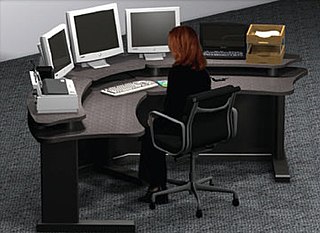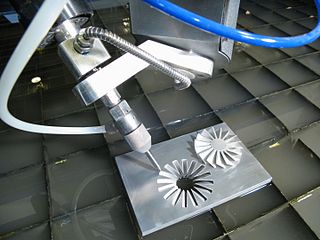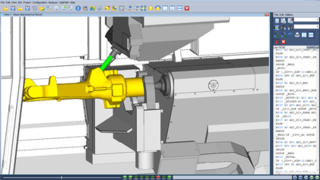Related Research Articles

Computer-aided manufacturing (CAM) also known as computer-aided modeling or computer-aided machining is the use of software to control machine tools in the manufacturing of work pieces. This is not the only definition for CAM, but it is the most common. It may also refer to the use of a computer to assist in all operations of a manufacturing plant, including planning, management, transportation and storage. Its primary purpose is to create a faster production process and components and tooling with more precise dimensions and material consistency, which in some cases, uses only the required amount of raw material, while simultaneously reducing energy consumption. CAM is now a system used in schools and lower educational purposes. CAM is a subsequent computer-aided process after computer-aided design (CAD) and sometimes computer-aided engineering (CAE), as the model generated in CAD and verified in CAE can be input into CAM software, which then controls the machine tool. CAM is used in many schools alongside computer-aided design (CAD) to create objects.

A machine tool is a machine for handling or machining metal or other rigid materials, usually by cutting, boring, grinding, shearing, or other forms of deformations. Machine tools employ some sort of tool that does the cutting or shaping. All machine tools have some means of constraining the workpiece and provide a guided movement of the parts of the machine. Thus, the relative movement between the workpiece and the cutting tool is controlled or constrained by the machine to at least some extent, rather than being entirely "offhand" or "freehand". It is a power-driven metal cutting machine which assists in managing the needed relative motion between cutting tool and the job that changes the size and shape of the job material.
Mastercam is a suite of Computer-Aided Manufacturing (CAM) and CAD/CAM software applications. Founded in MA in 1983, CNC Software, LLC is one of the oldest developers of PC-based computer-aided design / computer-aided manufacturing (CAD/CAM) software. They are one of the first to introduce CAD/CAM software designed for both machinists and engineers. Mastercam, CNC Software's main product, started as a 2D CAM system with CAD tools that let machinists design virtual parts on a computer screen and also guided computer numerical controlled (CNC) machine tools in the manufacture of parts. Since then, Mastercam has grown into the most widely used CAD/CAM package in the world. CNC Software, LLC is now located in Tolland, Connecticut.
G-code is the most widely used computer numerical control (CNC) and 3D Printing programming language. It is used mainly in computer-aided manufacturing to control automated machine tools, as well as for 3D-printer slicer applications. The 'G' stands for geometry. G-code has many variants.

CAD/CAM refers to the integration of Computer-aided design (CAD) and Computer-aided manufacturing (CAM). Both of these require powerful computers. CAD software helps designers and draftsmen; CAM "reduces manpower costs" in the manufacturing process.

Tebis is a CAD/CAM software provided by Tebis AG, with headquarters in Martinsried near Munich/Germany. Development locations: Martinsried and Norderstedt, Germany International locations: China, Spain, France, Italy, Portugal, Sweden, United Kingdom, USA.
A cutter location (CLData) refers to the position which a CNC milling machine has been instructed to hold a milling cutter by the instructions in the program.

Vero Software is a company based in Cheltenham, England, that specialises in CAD CAM.

STEP-NC is a machine tool control language that extends the ISO 10303 STEP standards with the machining model in ISO 14649, adding geometric dimension and tolerance data for inspection, and the STEP PDM model for integration into the wider enterprise. The combined result has been standardized as ISO 10303-238.
In manufacturing, threading is the process of creating a screw thread. More screw threads are produced each year than any other machine element. There are many methods of generating threads, including subtractive methods ; deformative or transformative methods ; additive methods ; or combinations thereof.
Cimatron is an Israeli software company that produces CAD/CAM software for manufacturing, toolmaking and CNC programming applications.

Multiaxis machining is a manufacturing process that involves tools that move in 4 or more directions and are used to manufacture parts out of metal or other materials by milling away excess material, by water jet cutting or by laser cutting. This type of machining was originally performed mechanically on large complex machines. These machines operated on 4, 5, 6, and even 12 axes which were controlled individually via levers that rested on cam plates. The cam plates offered the ability to control the tooling device, the table in which the part is secured, as well as rotating the tooling or part within the machine. Due to the machines size and complexity it took extensive amounts of time to set them up for production. Once computer numerically controlled machining was introduced it provided a faster, more efficient method for machining complex parts.

Sescoi is a developer of industrial software for computer-aided manufacturing, enterprise resource planning and extended enterprise productivity. Its WorkNC software is one of the market leaders in the CAD/CAM field and is used by more than 25% of companies in demanding countries such as Japan. Sescoi also develops WorkPLAN, a range of ERP software products for custom manufacturers and project based companies. As of 2011 Sescoi had more than 5000 customers and 11000 licenses sold worldwide. Sescoi and its products were acquired by Vero Software in January 2013.

WorkNC is a Computer aided manufacturing (CAM) software developed by Sescoi for multi-axis machining.

VoluMill is Computer Aided Manufacturing software developed by Celeritive Technologies that produces a toolpath designed for High Speed Machining applications. These applications include all 2-axis and 3-axis rough milling tasks, from simple prismatic parts to complex freeform molds. VoluMill is offered as a standalone version called VoluMill Universal, which is designed to work with any CAM system, and also as integrated versions that run inside hyperMILL, GibbsCAM, BobCAD-CAM, SigmaNEST, Mastercam, and NX (Unigraphics),RTM
SmartCAM is a suite of Computer-Aided Manufacturing (CAM) and CAD/CAM software applications that uses toolpath modeling to assist CNC machinists in creating computer-numerically controlled (CNC) programs that direct CNC machine tools.

Vericut, is a software program used for simulating CNC machining. It is used to simulate tool motion and the material removal process, detecting errors or areas of inefficiency in NC programs. It was developed by CGTech Inc. and first released in 1988.

Freeform surface or complex surfaces are widely manufactured nowadays. The industries which most often manufactures free-form surfaces are basically aerospace, automotive, die mold industries, bio medical and power sector for turbine blades manufacturing. Generally 3 or 5 axis CNC milling machine is used for this purpose. The manufacturing process of free form surface is not an easy job as the tool path generation in present CAM technology is generally based on geometric computation so tool path are not optimum. The geometry can also be not described explicitly so errors and discontinuities occurrence in the solid structure cannot be avoided. Free-form surfaces are machined with the help of different tool path generation method like adaptive iso-planar tool path generation, constant scallop tool path generation, adaptive iso-parametric method, iso-curvature, isophote and by other methods. The different methods are chosen based on the parameters which is needed to be optimized.
A Post Processor is a unique "driver" specific to a CNC machine, robot or mechanism; some machines start at different locations or require extra movement between each operation, the Post-Processor works with the CAM software or off-line programming software to make sure the G-Code output or program is correct for a specific Trademark machine Control Cabinet CAM software uses geometry from a CAD model and converts it to G-code. The CAM software analyzes the CAD model and determines what tooling and toolpaths will be used to mill the desired features. Doing so requires a CAM post processor that generates the exact G-code dialect used by the machine Control Module that is being targeted. An instance of such a translation is often referred to as a "post". There will be a different “post” for each G-code dialect the CAM software supports. Post Processors, rather the “post” uses an intermediate format that captures the G-code commands in a dialect-independent form. Most CAM software accomplishes this with an intermediate format called "CL.Data."

EXAPT is a production oriented programming language to generate NC programs with control information for machining tools and enables to consider production-related issues of various machining processes.
References
- ↑ Machining code at Surfware.Inc Dec. 2008 Freesteel
- ↑ A history
- ↑ USpatent 7451013,Coleman, Glenn; Diehl, Alan; Patterson, Robert B.,"Engagement milling",issued 2008-11-11